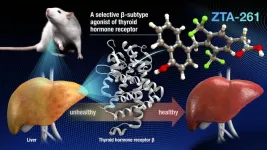(Press-News.org) People with higher levels of metals found in their blood and urine may be more likely to be diagnosed with — and die from — amyotrophic lateral sclerosis, or ALS, a University of Michigan-led study suggests.
Researchers have known that ALS, a rare but fatal neurodegenerative condition, is influenced by genetic and environmental factors, including exposure to pesticides and metals.
This latest study examined the levels of metals in the blood and urine of people with and without ALS, finding that exposure to individual and mixtures of metals is associated with a greater risk for ALS and shorter survival.
The results are published in the Journal of Neurology, Neurosurgery, and Psychiatry.
“Strengthening our understanding of the importance of exposure to metals as a risk factor for ALS is essential for future targeted prevention of the disease and improved therapeutic strategies,” said senior author Stephen Goutman, M.D., M.S., director of the Pranger ALS Clinic and associate director of the ALS Center of Excellence at University of Michigan.
“Several epidemiologic studies have linked metal exposure to ALS risk. Nonetheless, it remains critical for us to understand how these metal mixtures associate with ALS risk and survival and to identify who is at greatest risk of exposure or who is most susceptible to the exposure.”
Goutman’s team measured metal levels in plasma and urine samples from over 450 people with ALS and nearly 300 people without the condition.
They found that elevated levels of individual metals, including copper, selenium and zinc, significantly associated with higher ALS risk and earlier death.
They then used these results to create environmental ALS risk scores, similar to the polygenic risk scores previously developed at U-M. The environmental risk scores indicated that mixtures of metals in plasma and urine are linked to around a three-times greater risk for the disease.
In this study, the inclusion of an ALS polygenic risk score to assess a potential moderating effect of underlying genetic factors did not alter the association between metal exposure and disease risk or survival.
“While several studies suggest that environmental factors like metals interact with genetic variants to influence the onset, progression and severity of ALS, our study found that accounting for ALS polygenic risk scores did not influence the relationship between metal exposure and ALS,” said co-author Kelly Bakulski, Ph.D., associate professor of epidemiology at the University of Michigan School of Public Health.
“The relationships between genes and the environment on disease risk are complex, and future insights into other genetic factors or pathways that may be involved in ALS risk and metabolism of metals could enhance our understanding.”
Investigators also discovered that participants working in occupations with a higher likelihood of metal exposure had increased levels of metal mixtures in their blood and urine.
This echoes a previous study from the research team which found that people with ALS reported higher occupational exposure to metals prior to diagnosis.
“These findings emphasize the necessity of accounting for occupational and environmental factors when evaluating a person’s overall exposure risk,” said first author Dae Gyu Jang, Ph.D., postdoctoral fellow in the U-M Health Department of Neurology.
By avoiding high risk activities associated with metal exposures, Goutman says, individuals might lower their overall exposure and potentially mitigate risk.
“Our future research will further focus on what exposures have the strongest associations and their implications on the disease,” he said.
Additional authors: John Dou, M.P.H., Emily J. Koubek, Ph.D., Samuel Teener, Bhramar Mukherjee, Ph.D., Stuart A. Batterman, Ph.D., and Eva L. Feldman, M.D., Ph.D., all of University of Michigan, and Lili Zhao, Ph.D., of Corewell Health.
Funding for this study was provided in part by the National Institute of Neurological Disorders and Stroke (R01NS127188), the National Institute of Environmental Health Sciences (K23ES027221, R01ES030049), the Centers for Disease Control and Prevention (R01TS000344) and the ALS Association (20-IIA-532, 20-PP-661).
Paper Cited: “Multiple metal exposures associate with higher amyotrophic lateral sclerosis risk and mortality independent of genetic risk and correlate to self-reported exposures: a case-control study,” Journal of Neurology, Neurosurgery, and Psychiatry: DOI: 10.1136/jnnp-2024-333978
END
ALS diagnosis and survival linked to metals in blood, urine
Occupations with high metal exposure were also associated with an elevated risk for ALS
2024-08-06
ELSE PRESS RELEASES FROM THIS DATE:
Anxiety reframed can make business pitches more effective
2024-08-06
PULLMAN, Wash. – It may be possible to turn anxiety into a superpower in some scenarios, recent research with entrepreneurs indicates.
A Washington State University-led study found that if entrepreneurs preparing to make a funding pitch connected their pitch anxiety to their passion for their venture, judges ranked their performance higher. Perhaps even more importantly, the judges were also more likely to recommend them for funding.
This emotion reframing involved the entrepreneurs recognizing that they were feeling anxious partly because the project means so much to them. Entrepreneurs who tried other strategies ...
Study finds refined corn flour with added corn bran can lower cholesterol
2024-08-06
The findings of the randomized crossover clinical trial, available online now and slated to appear in an upcoming issue of the Journal of Nutrition, reveal simply swapping in foods made from refined corn flour + corn bran can lower LDL cholesterol concentrations by anywhere from 5% - 13.3% in just four weeks.
The trial compared the impact of whole-grain corn meal, refined corn meal, and a blend (refined corn meal plus corn bran) and found that 70% of the participants saw significant reductions in LDL cholesterol concentrations when consuming the blend. For the other corn flours, participants did not see a decrease in their LDL or total cholesterol ...
Carvings at ancient monument may be world’s oldest calendar
2024-08-06
Markings on a stone pillar at a 12,000 year-old archaeological site in Turkey likely represent the world’s oldest solar calendar, created as a memorial to a devastating comet strike, experts suggest.
The markings at Göbekli Tepe in southern Turkey – an ancient complex of temple-like enclosures adorned with intricately carved symbols – could record an astronomical event that triggered a key shift in human civilisation, researchers say.
The research suggests ancient people were able to record their observations of the sun, moon and constellations in ...
Sport or snack? How our brain decides
2024-08-06
In brief:
The chemical messenger orexin and the orexin neurons in the brain mediate the decision between exercise and snacking. Researchers at ETH Zurich made this discovery in mice. The results are likely to be transferable to humans.
In the experiment, mice with a blocked orexin system opted more frequently for the milkshake offered them and less for exercise.
These results could help in researching and developing new strategies to promote physical activity in people.
Should I go and exercise, or would I rather go to the café ...
A new way of thinking about the economy could help protect the Amazon, and help its people thrive
2024-08-06
To protect the Amazon and support the wellbeing of its people, its economy needs to shift from environmentally harmful production to a model built around the diversity of indigenous and rural communities, and standing forests.
A group of conservationists from Bolivia, Brazil, Peru, Ecuador, the US and the UK say that current conservation and development efforts will never sustain or scale without systemic changes in how economies are designed.
Despite extensive destruction of the Amazon in the name of economic development, Amazonian communities have seen little improvement in income, life expectancy, and education. The researchers have ...
Controlling lipid levels with less side effects possible with new drug
2024-08-06
Scientists at Nagoya University in Japan have made a significant breakthrough in treating lipid disorders. They have developed a new compound, ZTA-261, which selectively binds to the thyroid hormone receptor beta (THRβ). THRβ plays an important role in the regulation of lipid metabolism, which affects lipid levels in the blood. Mice administered the drug showed decreased lipid levels in the liver and blood, with fewer side effects in the liver, heart, and bones compared to existing compounds. These findings, published in Communications Medicine, suggest that ZTA-261 ...
Research spotlight: Analyzing the effectiveness of heart therapies and outcomes for patients with chip
2024-08-06
Nicholas A. Marston, MD, MPH, of the TIMI Study Group and Carl J. and Ruth Shapiro Cardiovascular Center at Brigham and Women’s Hospital, is the corresponding author of a paper published in Nature Medicine, “Clonal hematopoiesis, cardiovascular events and treatment benefit in 63,700 individuals from five TIMI randomized trials.”
How would you summarize your study for a lay audience?
Clonal hematopoiesis of indeterminate potential (CHIP) is a condition that promotes the multiplication of blood stem cells in the body and increases the ...
Soft gold enables connections between nerves and electronics
2024-08-06
Gold does not readily lend itself to being turned into long, thin threads. But researchers at Linköping University in Sweden have now managed to create gold nanowires and develop soft electrodes that can be connected to the nervous system. The electrodes are soft as nerves, stretchable and electrically conductive, and are projected to last for a long time in the body.
Some people have a “heart of gold”, so why not “nerves of gold”? In the future, it may be possible to use this precious metal in soft interfaces to connect electronics to the nervous system for medical ...
The race to discover biodiversity: 11 new marine species and a new platform for rapid species description
2024-08-06
Accelerating global change continues to threaten Earth’s vast biodiversity, including in the oceans, which remain largely unexplored. To date, only a small fraction of an estimated two million total living marine species have been named and described. A major challenge is the time it takes to scientifically describe and publish a new species, which is a crucial step in studying and protecting these species. The current scientific and publishing landscape often results in decade-long delays (20-40 years) from the discovery of a new species to its official description. As an ...
18th Annual Q-Bio Conference: Global scholars explore new Frontiers in quantitative biology
2024-08-06
The 18th Q-Bio Conference on Quantitative Biology was held at the Guangming Yungu International Conference Center in Shenzhen from July 26 to 29, 2024. Organized by the Shenzhen Institute of Advanced Technology (SIAT) of the Chinese Academy of Sciences (CAS), the Shenzhen Institute of Synthetic Biology (iSynBio), and Peking University, the conference drew over 230 global researchers from countries including the U.S., U.K., France, India, Japan, Chile, and China.
Themed "Predictive Modeling and Quantitative Principles in Complex Biological Systems," the event explored future prospects in quantitative and synthetic biology. Under ...
LAST 30 PRESS RELEASES:
New software sheds light on cancer’s hidden genetic networks
UT Health San Antonio awarded $3 million in CPRIT grants to bolster cancer research and prevention efforts in South Texas
Third symposium spotlights global challenge of new contaminants in China’s fight against pollution
From straw to soil harmony: International team reveals how biochar supercharges carbon-smart farming
Myeloma: How AI is redrawing the map of cancer care
Manhattan E. Charurat, Ph.D., MHS invested as the Homer and Martha Gudelsky Distinguished Professor in Medicine at the University of Maryland School of Medicine
Insilico Medicine’s Pharma.AI Q4 Winter Launch Recap: Revolutionizing drug discovery with cutting-edge AI innovations, accelerating the path to pharmaceutical superintelligence
Nanoplastics have diet-dependent impacts on digestive system health
Brain neuron death occurs throughout life and increases with age, a natural human protein drug may halt neuron death in Alzheimer’s disease
SPIE and CLP announce the recipients of the 2025 Advanced Photonics Young Innovator Award
Lessons from the Caldor Fire’s Christmas Valley ‘Miracle’
Ant societies rose by trading individual protection for collective power
Research reveals how ancient viral DNA shapes early embryonic development
A molecular gatekeeper that controls protein synthesis
New ‘cloaking device’ concept to shield sensitive tech from magnetic fields
Researchers show impact of mountain building and climate change on alpine biodiversity
Study models the transition from Neanderthals to modern humans in Europe
University of Phoenix College of Doctoral Studies releases white paper on AI-driven skilling to reduce burnout and restore worker autonomy
AIs fail at the game of visual “telephone”
The levers for a sustainable food system
Potential changes in US homelessness by ending federal support for housing first programs
Vulnerability of large language models to prompt injection when providing medical advice
Researchers develop new system for high-energy-density, long-life, multi-electron transfer bromine-based flow batteries
Ending federal support for housing first programs could increase U.S. homelessness by 5% in one year, new JAMA study finds
New research uncovers molecular ‘safety switch’ shielding cancers from immune attack
Bacteria resisting viral infection can still sink carbon to ocean floor
Younger biological age may increase depression risk in older women during COVID-19
Bharat Innovates 2026 National Basecamp Showcases India’s Most Promising Deep-Tech Ventures
Here’s what determines whether your income level rises or falls
SCIE indexation achievement: Celebrate with Space: Science & Technology
[Press-News.org] ALS diagnosis and survival linked to metals in blood, urineOccupations with high metal exposure were also associated with an elevated risk for ALS





